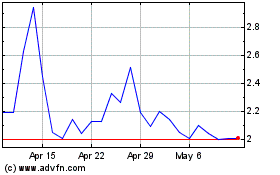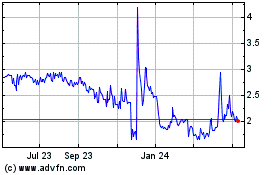Alterity Therapeutics (ASX: ATH, NASDAQ: ATHE) (“Alterity” or “the
Company”), a biotechnology company dedicated to developing disease
modifying treatments for neurodegenerative diseases, today released
its Appendix 4C Quarterly Cash Flow Report and update on company
activities for the quarter ending 30 September 2024 (Q1 FY25).
“We are excited about what this fiscal year has
to offer as we started by reporting promising data from our Phase 2
clinical trial in participants with advanced multiple system
atrophy (MSA),” said, David Stamler, M.D., Chief Executive Officer
of Alterity. “The interim results from the ATH434-202 study suggest
that ATH434 has potential to modify disease progression.
Importantly, the stabilization of iron content in certain brain
regions, combined with key biomarker data, indicates that ATH434
may slow neurodegeneration by modulating brain iron levels and
reducing oxidative injury. These early data are an exciting
indicator of what we might expect to see from our ATH434-201 trial
in MSA patients with early-stage disease that is expected to read
out in January 2025.”
“Last month, we delivered multiple presentations
at the International Congress of Parkinson’s Disease and Movement
Disorders® (MDS), a prominent neurology meeting. At this event, we
presented clinical and preclinical data demonstrating the potential
of ATH434 in a variety of neurological conditions including
early-stage MSA, advanced MSA, and Parkinson’s disease. We look
forward to presenting additional data at medical meetings, and the
topline results from both our ATH434-201 and ATH434-202 trials in
calendar year 2025,” added, Dr. Stamler.
Alterity’s cash position on 30 September 2024
was A$9.28 with operating cash outflows for the quarter of
A$3.31M.
In accordance with ASX Listing Rule 4.7C,
payments of A$94k made to related parties and their associates
included in item 6.1 of the Appendix 4C incorporates directors’
fees, consulting fees, remuneration and superannuation at
commercial rates.
Operational Activities
ATH434–202: Open-label, Biomarker Phase 2
Clinical Trial in Advanced MSA
On 17 July 2024, Alterity reported positive
interim data from the ATH434-202 trial in participants with
advanced MSA. The data were also presented in September 2024 as
both a late-breaking oral presentation and poster session by Daniel
O. Claassen, M.D., M.S., Professor of Neurology, Vanderbilt
University Medical Center at the International Congress of
Parkinson’s Disease and Movement Disorders® (MDS). The early
outcomes reported from the interim analysis suggest that ATH434 has
potential to modify disease progression.
The interim analysis included clinical and
biomarker data on 7 participants treated with ATH434 for 6 months
and neuroimaging data on 3 participants who were treated for 12
months. ATH434 was well tolerated with no drug-related serious
adverse events, and most adverse events were mild to moderate,
showing a favorable safety profile.
The data suggest that ATH434 may have a
disease-modifying effect in MSA, as 30% of participants had stable
or improved clinical outcomes (clinical responders). The average
change in Unified MSA Rating Scale Part I (UMSARS I) scores over 6
months was smaller than observed in a historical group of untreated
MSA patients, suggesting reduced disability on activities of daily
living.
At 6 months all participants exhibited brain
volume declines consistent with MSA progression; however, the
clinical responders maintained stable brain volumes at 12 months.
Importantly, the clinical responders on average showed stability in
iron levels on MRI in the substantia nigra, putamen and globus
pallidus, as well as stable levels of Neurofilament light chain
(NfL), a marker of axonal injury, when compared to participants who
declined. The stabilization of iron content in these subcortical
brain regions, combined with NfL biomarker data, indicates that
ATH434 may slow neurodegeneration by modulating brain iron levels
and reducing oxidative injury.
The trial remains ongoing with Topline 12-month
results expected in the first half of calendar year 2025.
ATH434–201: Randomized, Double-Blind Phase 2
Clinical Trial in Early-State MSA
In September 2024, Dr. Stamler delivered an Oral
Platform presentation and poster session at MDS, entitled, “A Phase
2 Study of ATH434, a Novel Inhibitor of α-Synuclein Aggregation,
for the Treatment of Multiple System Atrophy”. The oral
presentation and poster described the baseline characteristics for
the 77 participants from Alterity’s ATH434-201 randomized,
double-blind Phase 2 clinical trial, with a focus on baseline fluid
biomarkers, neuroimaging and clinical data. The participants met
strict selection criteria designed to confirm they had early-stage
(clinically probable) MSA.
The presentation further demonstrated that
increased iron levels were evident in multiple subcortical brain
regions, with increases being observed in the substantia nigra in
nearly all subjects, and that ATH434 has potential to slow
neurodegeneration based on its ability to redistribute this excess
brain iron. Data were also presented indicating that plasma levels
of neurofilament light chain, a marker of neuronal injury, were
correlated with disease severity at baseline.
The trial remains on track to complete in
November 2024. The data from the trial will then be analyzed and
the Company expects to report topline results in January 2025.
bioMUSE Natural History Study
The Company’s “Biomarkers of progression in
Multiple System Atrophy” (bioMUSE) natural history study continues
to produce promising data to track the progression of individuals
with MSA and characterize MSA in terms of various biomarkers. At
the MDS meeting in September 2024, a poster featuring bioMUSE data
was presented entitled, “Association Between Clinical Progression
in Multiple System Atrophy and Brain Volume Changes Evaluated via
Deep Learning Segmentation”. The poster described the novel MRI
imaging techniques and deep learning segmentation that were used to
assess brain volume in MSA brain regions of interest (ROI) in
bioMUSE participants. Structural MRI plays a critical role in both
diagnosing MSA and monitoring disease progression. Subcortical
brain volume shows potential as a biomarker for evaluating
disease-modifying therapies.
Over the course of one year, MRI with
deep-learning segmentation revealed significant brain volume
reduction in MSA ROIs whereas Parkinson’s disease patients showed
no significant brain volume changes. In contrast, the MSA patients
exhibited significant volume reductions in the cerebellum, globus
pallidus, and brainstem. In addition, patients with the
parkinsonian variant of MSA showed significant volume loss in the
putamen. The results illustrate the correlation between the brain
volume reduction and worsening clinical scores, as measured by the
UMSARS, providing the basis for subcortical brain volume as a
potential biomarker in treatment studies.
ATH434 for the Treatment of Parkinson’s
Disease
In September 2024, a poster was presented at MDS
entitled, “Effects of ATH434, a Clinical-Phase Small Molecule with
Moderate Affinity for Iron, in Hemiparkinsonian Macaques”. The
presentation demonstrated that ATH434 treatment led to lower iron
levels in the affected area of the brain, the substantia nigra, and
improved motor performance and general function in monkeys with
experimentally induced Parkinson’s disease.
At week 12, all 5 ATH434-treated macaques had
stable or improving scores from Baseline while two of three
vehicle-treated macaques did not demonstrate improvement. The
improved general behavior was well-correlated with reduced motor
impairment. These favorable parkinsonian outcomes observed in each
of the ATH434-treated monkeys were also associated with increased
levels of striatal synaptophysin, a protein marker that reflects
functional connections between neurons, suggesting functional
recovery of nerve endings in this critical motor pathway. These
results support further investigation of ATH434 for the treatment
of Parkinson’s disease.
Corporate Activities
On September 30, 2024, Alterity announced Abby
Macnish Niven as the Company’s Chief Financial Officer. Ms Macnish
Niven consults for a range of listed and unlisted companies in
governance, finance and corporate structure. She holds Bachelor of
Commerce and Bachelor of Science degrees from University of Western
Australia and is a Chartered Finance Analyst.
During the quarter, management participated in
multiple investor activities including a webinar hosted by MST
Financial, and a presentation hosted by ShareCafe.
About Alterity Therapeutics
Limited
Alterity Therapeutics is a clinical stage
biotechnology company dedicated to creating an alternate future for
people living with neurodegenerative diseases. The Company’s
lead asset, ATH434, has the potential to treat various Parkinsonian
disorders and is currently being evaluated in two Phase 2 clinical
trials in Multiple System Atrophy. Alterity also has a broad drug
discovery platform generating patentable chemical compounds to
treat the underlying pathology of neurological diseases. The
Company is based in Melbourne, Australia, and San Francisco,
California, USA. For further information please visit the Company’s
web site at www.alteritytherapeutics.com.
Authorisation & Additional informationThis
announcement was authorized by David Stamler, CEO of Alterity
Therapeutics Limited.
Investor and Media Contacts:
AustraliaAna Luiza
Harropwe-aualteritytherapeutics@we-worldwide.com+61 452 510 255
U.S.Remy Bernardaremy.bernarda@iradvisory.com
+1 (415) 203-6386
Forward Looking Statements
This press release contains "forward-looking
statements" within the meaning of section 27A of the Securities Act
of 1933 and section 21E of the Securities Exchange Act of 1934. The
Company has tried to identify such forward-looking statements by
use of such words as "expects," "intends," "hopes," "anticipates,"
"believes," "could," "may," "evidences" and "estimates," and other
similar expressions, but these words are not the exclusive means of
identifying such statements.
Important factors that could cause actual
results to differ materially from those indicated by such
forward-looking statements are described in the sections titled
“Risk Factors” in the Company’s filings with the SEC, including its
most recent Annual Report on Form 20-F as well as reports on Form
6-K, including, but not limited to the following: statements
relating to the Company's drug development program, including, but
not limited to the initiation, progress and outcomes of clinical
trials of the Company's drug development program, including, but
not limited to, ATH434, and any other statements that are not
historical facts. Such statements involve risks and uncertainties,
including, but not limited to, those risks and uncertainties
relating to the difficulties or delays in financing, development,
testing, regulatory approval, production and marketing of the
Company’s drug components, including, but not limited to, ATH434,
the ability of the Company to procure additional future sources of
financing, unexpected adverse side effects or inadequate
therapeutic efficacy of the Company's drug compounds, including,
but not limited to, ATH434, that could slow or prevent products
coming to market, the uncertainty of obtaining patent protection
for the Company's intellectual property or trade secrets, the
uncertainty of successfully enforcing the Company’s patent rights
and the uncertainty of the Company freedom to operate.
Any forward-looking statement made by us in this
press release is based only on information currently available to
us and speaks only as of the date on which it is made. We undertake
no obligation to publicly update any forward-looking statement,
whether written or oral, that may be made from time to time,
whether as a result of new information, future developments or
otherwise.
Alterity Therapeutics (NASDAQ:ATHE)
Historical Stock Chart
From Nov 2024 to Dec 2024

Alterity Therapeutics (NASDAQ:ATHE)
Historical Stock Chart
From Dec 2023 to Dec 2024
